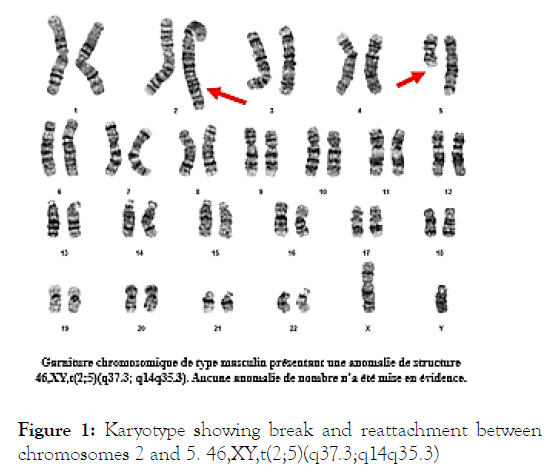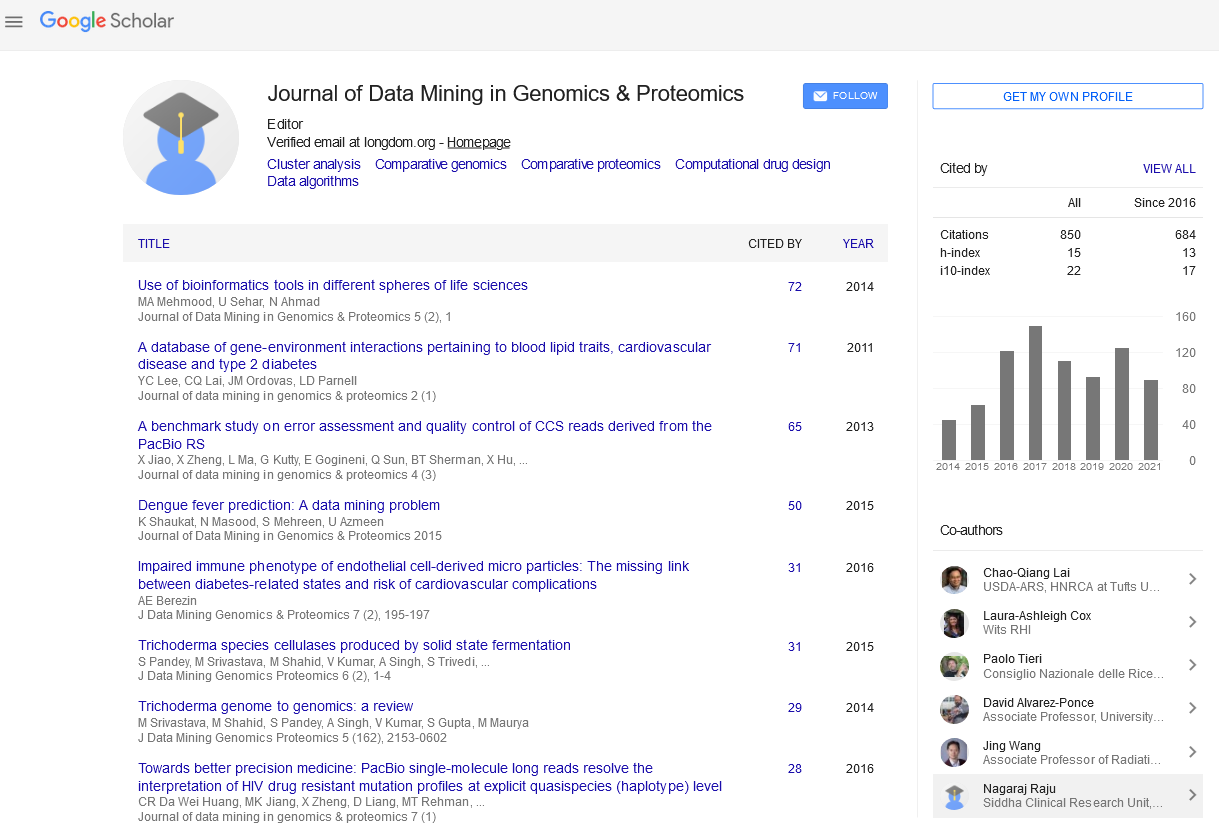PMC/PubMed Indexed Articles
Indexed In
- Academic Journals Database
- Open J Gate
- Genamics JournalSeek
- JournalTOCs
- ResearchBible
- Ulrich's Periodicals Directory
- Electronic Journals Library
- RefSeek
- Hamdard University
- EBSCO A-Z
- OCLC- WorldCat
- Scholarsteer
- SWB online catalog
- Virtual Library of Biology (vifabio)
- Publons
- MIAR
- Geneva Foundation for Medical Education and Research
- Euro Pub
- Google Scholar
Useful Links
Share This Page
Journal Flyer

Open Access Journals
- Agri and Aquaculture
- Biochemistry
- Bioinformatics & Systems Biology
- Business & Management
- Chemistry
- Clinical Sciences
- Engineering
- Food & Nutrition
- General Science
- Genetics & Molecular Biology
- Immunology & Microbiology
- Medical Sciences
- Neuroscience & Psychology
- Nursing & Health Care
- Pharmaceutical Sciences
Short Communication - (2021) Volume 12, Issue 3
Translocation (2; 5) (q37.3, q14q35.3) in a Case of Male Infertility in Cotonou
Azonbakin Simon*, Aweh Bruno, Adovoekpe Diane, M Gbedo, Goussanou Yannick, Agbanlinsou A, Adjagba Mahouna Philippe, Gangbo Flore and Laleye AnatoleReceived: 04-May-2021 Published: 25-May-2021, DOI: 10.35248/2153-0602.21.12.241
Abstract
Couple infertility is one of the major public health problems nowadays. Genetic etiologies are rarely discussed in our country, because of the predominance of infectious causes. Here we report a case of translocation t (2; 5) (q37.3;14 q35.3) explaining infertility in a 50-year-old man with a spermogram showing astheno teratozoospermia and normal phenotypic examination.
Keywords
Infertility; t (2, 5) (q37.3, q14q35.3); Karyotype; Astheno-teratozoospermia
Introduction
Couple infertility becomes a public health problem nowadays since it affects according to World Health Organisation (WHO) 10 to 15% of the couples [1]. This rate is higher in sub-Saharan Africa where the prevalence of infertility in the couple is estimated between 15 and 30% [2]. Men are involved in couple infertility in more than half of cases. The main causes of male infertility are infectious, immune and genetic in 2.5% of cases [3]. When the cause is genetic, it may be either chromosomal abnormalities or genic involving different genes. Among the infertile men, 5.8% present a chromosome anomaly with 4.2% which concerns the gonosomes and 1.5% the autosomes [4]. Advances in research techniques in molecular cytogenetics and molecular biology have made it possible to refine the diagnosis of these cases of infertility and to measure their prognosis [5]. We report a case of t (2; 5) translocation found in a karyotype of an infertile man at the Laboratory of Histology Reproductive Biology, Cytogenetics and Medical Genetics of the Faculty of Health Sciences of Cotonou.
Patient
Patient ZC, 50 years old, was sent to laboratory for diagnosis of infertility of the couple. He was born from a nonconsanguineous marriage and have two sisters with a poorly documented primary infertility. He cohabits with a 35 years old woman since 12 years without child. Physical examination revealed any particularity, the genital organs were normal , the testicles are well housed in the purses with good appearance. He was sent to our laboratory for spermogram on which an asthenoteratospermia was noted. A progressive mobility of 14% and 2% of spermatozoa with a normal morphology. The G-band karyotype after lymphocyte culture at a resolution of 550 bands showed a male-type chromosomal trimming with a structural abnormality: 46, XY, t (2; 5) (q37.3; q14q35.3) ( Figure 1) . No other number abnormalities were highlighted.

Figure 1: Karyotype showing break and reattachment between chromosomes 2 and 5. 46,XY,t(2;5)(q37.3;q14q35.3)
Discussion
Several abnormalities can be at the origin of disorders of the fertility in the man. The results of several cohort studies have revealed the various chromosomal abnormalities observed in male sterility [6]. Depending of the countries and series, the chromosomal causes of infertility are more frequent in men with a significant decrease in the number of spermatozoa. Although robertsonnian translocations are better known as an important cause of infertility in the couple, reciprocal translocations are often poorly described. It can be done between autosomes or between autosome and sex chromosome [5,7]. That between chromosomes 2 and 5 has not been found in the literature in our knowledge. Would you be the real cause of infertility in our patient? Two mechanisms could explain the link between the infertility of our patient and this chromosomal anomaly.
- An involvement of a spermatogenesis gene located in the region of chromosomal breakage;
- Either a spermatogenesis disorder related to a meiotic nondisjunction.
For the first mechanism, the breakpoints may relate to a gene of interest and cause its interruption with the consequence of a given phenotypic manifestation. In our case, at the level of locus 2q37 is among many others, the NCL gene that codes for the Nucleolin protein involved in the decondensation of DNA [8]. At the locus 5q35.3 is among others the gene SGSTM1 which codes for the protein Sequestosome, protein involved in the occurrence of oxidative stress.
The mechanism seems more likely than that of the involvement of genes of interest located at breakpoints, because of the random nature of the chromosomal breakpoints. Thus, these reciprocal translocations result in a disorder of chromosome segregation during meiosis with possibility of formation of abnormal gametes, responsible later for miscarriages; hypo fertility [5].
However, in the literature, other cases of t (2; 5) had been reported, but these translocations were rather related to lymphomas [9,10]. On the molecular level, Vega et al. reported in 2003 a case of lymphoma with a t (2; 5). It’s was responsible for the fusion of 2genes ALM and NPM genes respectively located on chromosomes 2 and 5 with the formation of a new gene that encodes a tyrosine kinase which happens to be a potent oncogene [10]. It may therefore be suggested that the clinical manifestations in the cases of t (2; 5) would vary according to the breakpoints. In our case, the occurrence of infertility because of a meiotic disjunction cannot be formally excluded.
Conclusion
Translocation t (2; 5) (q37.3; q14q35.3) is a very rare genetic abnormality that has been diagnosed by conventional cytogenetic techniques. Further examinations such as comparative gnomic hybridization in molecular cytogenetics are indicated for better investigation in our patient. Genetic counseling is also in perspective in our patient.
REFERENCES
- Jégou B. Male Infertility today. Med Sci (Paris). 2012;28(5):447-448
- Wallerand H, Chabannes E, Bittard H. Idiopathic male infertility and androgen receptors. Prog Urol. 2001;11(4):610-620.
- Thonneau P, Marchand S, Tallec A, Ferial M L, Ducot B, Lansac J, and et al. Incidence and main causes of infertility in a resident population (1,850,000) of three French regions (1988-1989). Hum Reprod. 1991;6(6):811-816.
- Wallerand H, Bernardini S, Chabannes E, Bittard H. Genetic cause of male infertility and molecular biology. Prog Urol. 2003;13(4):560-3.
- Vialard BF. Mandon-Pépin F. Pellestor A. Ziyyat M. Albert D. Molina-Gomes et al. Genetic analysis of human male infertility. Androl.2009;19:2-16.
- Luciani JM, Guichaoua MR. Incidence of structural chromosomal abnormalities in spermatogenesis in man. Reprod Nutr Dev. 1990;Suppl 1:95s-103s
- Siffroi JP, Le Bourhis C, Krausz C, Dadoune JP . Sex chromosomemosaicism in males carrying Y chromosome long arm deletions. HumReprod. 2000;15(12):2559-2562.
- Erard MS, Belenguer P, Caizergues-Ferrer M, Pantaloni I, Almaric F. Amajor nucleolar protein, nucleolin, induces chrolatin decondensation by binding to histone H1. Eur J Biochem. 1988 15;175(3):525-530
- Decoteau JF, Butmarc JR, Kinney MC, Kadin ME. The t(2;5) chromosomal translocation is not a common feature of primary cutaneous CD30+ lymphoproliferative disorders: comparison with anaplastic large-cell lymphoma of nodal origin. Blood. 1996.15;87(8):3437-3441.
- Vega F, Medeiros J. Chromosomal translocations involved in Non- Hodgkin Lymphomas. Arch Path Lab Med. 2003;127(9):1148-1160
Citation: Simon A, Bruno A, Diane A, Gbedo M, Goussanou Y, Agbanlinsou A, et al. (2021). Translocation (2; 5) (q37.3, q14q35.3) in a Case of Male Infertility in Cotonou. J Data Mining Genomics Proteomics. 12:241
Copyright: © 2021 Simon A, et al. This is an open-access article distributed under the terms of the Creative Commons Attribution License, which permits unrestricted use, distribution, and reproduction in any medium, provided the original author and source are credited.
Sources of funding : no


